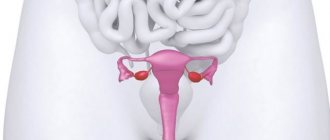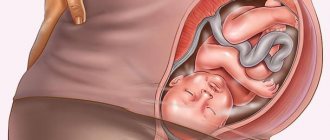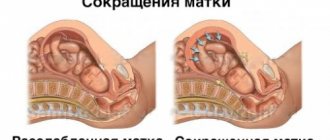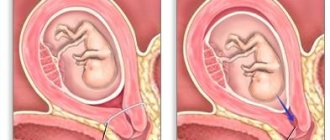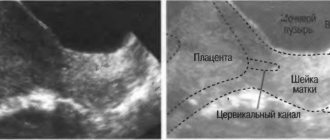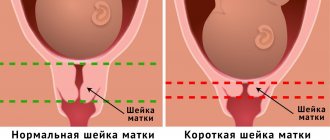Women who are approaching their due date ask a completely natural question about how to relax the cervix. This interest in this process is due to the fact that with proper preparation of the reproductive organs, the likelihood of injury can be reduced, including rupture of the tissue of the uterus and labia.
Such complications are quite common, and are subsequently resolved through surgical interventions, accompanied by a long recovery period. You can avoid all this, the main thing is to know how to relax the cervix at home.
Why is uterine tone dangerous at different stages of pregnancy?
Long-term hypertension negatively affects the baby and the health of the mother. In the first trimester, due to increased uterine tone, spontaneous abortion may occur. And also sometimes the development of a frozen pregnancy is observed, as a result of which the embryo dies in the womb.
In the second and third trimesters of pregnancy, the consequences of high uterine tone can provoke spontaneous miscarriage or premature birth. Therefore, it is very important to control the tone, and if discomfort occurs, contact a gynecologist.
When the muscles contract, the walls of the uterus compress the placenta, and this, in turn, negatively affects the development of the fetus. The required amount of oxygen does not reach the baby's place, and because of this, fetal development may be delayed. At the beginning of pregnancy, the child may even die from such pathological processes.
Uterine muscle tone
Muscle fibers contract under the influence of impulses from the central and autonomic nervous systems; this condition is called uterine muscle tone. During pregnancy, the muscles are in a relaxed state of normal tone; when the fibers are excited, we can talk about hypertonicity. Hypertonicity of the uterine muscles is a pregnancy-threatening condition.
Causes of increased uterine tone:
- stressful situations;
- physical stress;
- uterine hypoplasia;
- endometriosis;
- uterine fibroids;
- infectious diseases;
- polyhydramnios;
- exposure to adverse environmental factors;
- bad habits of the mother;
- history of abortions and miscarriages.
How to relieve uterine tone at home
According to doctors, to reduce hypertension at home, you can use the following treatment methods:
Diet
First of all, in order to avoid complications when carrying a child, and to ensure that your health is normal, you need to adjust your diet. It is necessary to include as many foods high in magnesium in your diet as possible.
A girl should consume 300–400 mg of foods containing magnesium per day.
The menu should include the following products:
- Bran bread or baked goods made from bran.
- Buckwheat and oatmeal porridge with milk, honey or sugar.
- Legumes (it is best to make soups and main courses from beans).
- Vegetables (to reduce tone you need to eat asparagus, fresh cucumbers, broccoli, green bell peppers).
- Nuts and dried fruits.
- Meat (veal, pork, chicken, rabbit).
Some foods can provoke an increase in tone.
Therefore, to minimize the risk of a problem, it is recommended to exclude from the diet:
- black/green strong tea, coffee, drinks containing caffeine, alcohol;
- carbonated drinks and sparkling mineral water;
- fatty foods;
- fast food.
It is best to switch to a healthy diet high in protein, fiber and magnesium. You need to eat 5-6 times a day in fractional portions. Your doctor will help you adjust your nutrition menu.
Physiotherapy
Special therapeutic exercises designed for pregnant girls will help cope with the problem. Exercises will help cure pathology and strengthen muscles.
To relieve discomfort you need:
- According to scientists, if you relax your facial muscles, your whole body will automatically relax.
Therefore, if the first signs of illness appear, then you need to take a comfortable position while sitting on a sofa or chair and try to completely relax your face and neck. You should breathe calmly and evenly. After 3-5 minutes, the pain should go away and the woman will feel relaxed. By regularly performing this exercise, the expectant mother will be able to learn to keep her body under control. - The “cat” exercise will effectively help you cope with pain.
The girl needs to get on all fours and lower her head down. After which we gradually raise our heads up and stretch our stomachs towards the floor. When we raise our head, we take a deep breath, when we lower it, we exhale. All muscles of the body should be as relaxed as possible. After bending your back in the position, you need to linger for 7-10 seconds, and then return to the starting position and exhale. All movements are made smoothly and slowly. The entire action should be repeated 3–5 times, then the girl should rest for several hours in a lying position. - Knee-elbow pose.
Another effective exercise that eliminates discomfort in the lower abdomen. You need to kneel down and rest your elbows on the floor. You need to hold this position for 50–60 seconds, then lie down on the sofa/bed and remain at rest for 1.5–2 hours.
By systematically performing these easy exercises, a girl will not only remove pain in the lower abdomen, but also improve the condition of the whole body, strengthen the muscles and make them more elastic.
Using a bandage
The bandage supports the abdomen, thereby relieving tension from the back and reducing the tone of the uterus. Obstetricians and gynecologists recommend pregnant women to wear a bandage starting from 17–18 weeks. And from 30-32 weeks it should be abandoned as the baby’s size increases, and the belt can interfere with this process.
For each girl in position, the elastic belt is selected separately, taking into account individual characteristics. The bandage is made of natural cotton or synthetic material. It does not restrict movement and effectively helps support a growing belly.
Today there are several types of elastic belts for pregnant women.
Highlight:
- Underwear.
Available in the form of panties. The upper part of the underwear has an elastic band sewn onto it, which helps support the belly. This type of bandage does not cause discomfort, it is comfortable and is most popular among pregnant girls. - Elastic waistband.
Bandage in the form of a wide elastic tape with Velcro. It is worn over the underwear on the body. There are special adjusters on the side that will help you choose the desired girth diameter. - Universal bandage.
Used during pregnancy and the postpartum period. It has the shape of a wide belt (similar to a corset). There are special fasteners on the side to adjust the width and girth.
Folk remedies
At home, folk remedies will help get rid of increased tone. In this situation, tinctures and decoctions of medicinal herbs are best suited. They have an antispasmodic effect, which helps reduce pain.
The following list of recipes effectively normalizes tone:
- Valerian tinctures. The drug is allowed to be taken during pregnancy. It can be used both as a preventative and to treat spasms. You need to drink 33-35 drops of the medicine 27-30 minutes before meals.
- Motherwort tincture. Drink 27–29 drops 2 times a day (morning and evening) immediately after meals. The course of treatment lasts 1.5–2 months.
- Tea from medicinal herbs. To make tea you will need lemon balm, mint, valerian, motherwort. Mix all ingredients, 90 g each, and pour boiling water. Leave to infuse for 35–40 minutes. If desired, you can add honey and sugar to the tea. After drinking the drink, you need to lie down at rest for 23–25 minutes.
Before self-medicating and taking folk remedies, you should consult your doctor for advice. After the doctor confirms that the woman has hypertension and really needs to be lowered, he will prescribe special medications or traditional medicines to normalize the condition.
Aromatherapy
Aroma oils help the body relax and calm down. Therefore, to cope with hypertension, buy or make your own pendant with oils. And also a fairly effective procedure is a bath with essential oils (it is important to remember that the water should be warm).
For this procedure you will need:
- jasmine (improves the functioning of the nervous system, relieves tension, has a pleasant delicate aroma);
- lotus (calms, invigorates, has a light sweet aroma);
- rose (relieves tension, calms, bright rich scent of a flower);
- vanilla (brings a feeling of peace and comfort, has sweet notes);
- medicinal herbs (geranium, valerian, chamomile, lemon balm).
In addition to baths and pendants, you can place small bowls of oils or aroma candles around the house. The smell should be light and pleasant. This will help relieve tension, calm down and relax.
Methods
As you know, during pregnancy it is better not to take any medications unless there are medical recommendations, but they are not necessary to relax the cervix before labor. Of course, you won’t be able to completely give up medications, but sometimes it will be useful to conduct classes using other methods. Therefore, we will consider the most effective ways of preparation.
Sex
Many married couples are wary of intimacy in the last months of pregnancy. But this is due, in most cases, to insufficient knowledge regarding human physiology and anatomy. Oddly enough, the best way to relax the cervix at home is to achieve orgasm.
Semen contains substances such as prostaglandins. Under their influence, the cervical part of the reproductive organ matures. However, it is very important not just to engage in sexual intercourse, but to achieve the ultimate goal. This relaxation technique is allowed only in the last month of pregnancy, so as not to provoke premature birth.
Primrose
To make the cervical muscles more elastic, you can use evening primrose oil at home. This herbal remedy can be purchased at almost every pharmacy. It has a fairly convenient release form - capsules with oil inside, intended for oral administration.
What does a herbal preparation for softening the cervix look like? Source: vivasan.mobi
They must be drunk after completing 34 weeks of gestation according to the following scheme:
- During the first 7 days, drink 1 capsule;
- From 36 to 38 weeks, take two capsules;
- Subsequently, you need to drink 1-3 capsules per day.
The drug does not have a negative effect on the process of intrauterine development of the fetus. However, before starting treatment, it is necessary to make sure that the woman is not allergic to it. The principle of action is based on the fact that evening primrose oil contains many fatty acids, which activate the function of producing prostaglandins in the body, which can relax the muscles of the cervix.
Herbs
Often, during the preparatory stage for labor, when the task is to relax the muscles of the cervix, expectant mothers resort to the use of traditional medicine. Often, all recommendations boil down to the need to use decoctions or teas made from medicinal plants.
It is worth saying that many doctors are skeptical about such methods, however, from the reviews of women it can be understood that they are effective. Before starting to use folk remedies, you need to make sure that the girl does not have individual intolerance to herbs.
Tansy should not be used to relax the cervix. Source: 1000listnik.ru
You should approach the choice of plants very responsibly, so together with your doctor it is better to determine which of them may be dangerous. For example, it is reliably known that wild rosemary, tansy and elecampane have a negative effect on the expectant mother and child. Of course, they are able to relax the muscles of the cervix, but they can also cause early labor and lead to intoxication of the body, which can cause death.
It is best to make decoctions and brew medicinal teas based on the following medicinal plants:
- Raspberry leaves;
- Dog-rose fruit;
- Hawthorn leaves and fruits;
- Sage;
- Dried St. John's wort.
The cooking method is quite simple. You need to take your favorite mug, put one teaspoon of the selected herb in it, pour boiling water over it, and take it 3 times a day. Thanks to this, the cervical muscle will gradually relax. A decoction of viburnum, which can be taken no earlier than two weeks before the expected birth, also copes well with the task.
Massage
Many women may not even realize that regular nipple massage is sometimes enough to relax the uterus at home. The main feature of this method is that all movements should be slow, simulating the process of a baby sucking at the breast. The response of the pituitary part of the brain to such actions will be the production of oxytocin, which will definitely lead to contraction of the uterus.
Massaging the nipples stimulates the production of oxytocin. Source: help-me.pp.ua
The average duration of the procedure should be 15 minutes, but it is advisable to take it up to half an hour. Women sometimes indicate that during a massage they feel slight pain or discomfort in the lower abdomen. This only means that the technique is truly effective and the desired result is achieved.
Drug treatment of pathology
If folk remedies do not help, and the problem has become more severe, doctors resort to medication to treat the disease. Constant tone can cause severe pain, which can provoke miscarriage or premature birth. Therefore, it is absolutely impossible to postpone treatment of the disease.
When making such a diagnosis, the doctor is obliged to tell the woman exactly what medications to take for severe pain and discomfort in the lower abdomen.
Typically, a girl is prescribed the following groups of medications:
- antispasmodic medications (No-shpa, Papaverine, Utrozhestan);
- vitamin B6 and magnesium capsules (Magnesia);
- sodalite spectrum products (soothing natural medicines: valerian, motherwort, chamomile in tablet form);
- hormonal drugs (progesterone, antipode, Duphaston, Ginipral).
The course of treatment, dosage and name of the drugs are determined by the attending physician depending on the duration of pregnancy, the woman’s health condition and individual characteristics. In addition, factors that provoke the occurrence of the disease play an important role.
In some cases, medication may not be required. Self-medication with unknown medications is prohibited, as this can negatively affect the development of the fetus and the general well-being of the woman.
How to relax the muscles of the uterus?
If unpleasant sensations associated with tension in the muscles of the uterus appear, a pregnant woman needs to relax; breathing exercises, relaxing aromas, soothing tea or a set of exercises can help with this. The choice of the most effective method of relaxing the muscles of the uterus is individual; it all depends on the preferences of the expectant mother, physical capabilities and health status. In some cases, it is necessary to resort to drug therapy.
Drugs to relax the muscles of the uterus
The following drugs have a toxic effect on the muscles of the uterus:
Indications: this drug is prescribed when there is a threat of miscarriage in the later stages, during the period of labor, in case of acute intrauterine asphyxia of the fetus.
Side effects: after using Ginipral, a pregnant woman may complain of headache, nausea, rarely vomiting, tremor, feelings of restlessness and anxiety, severe sweating.
Contraindications: diseases of the endocrine system, heart rhythm disturbances, myocarditis, renal and liver failure, uterine bleeding, placental abruption, allergic intolerance to the substances included in the drug.
Indications: threatened miscarriage, postoperative period during pregnancy.
Side effects: slight decrease in blood pressure, rapid heartbeat, tremor, muscle weakness, severe sweating.
Contraindications: diseases of the cardiovascular system, thyroid diseases, glaucoma.
Indications: the drug is prescribed for threatened miscarriage, Raynaud's disease, peripheral vascular spasm.
Side effects: decreased blood pressure, severe dizziness, nausea, in rare cases, vomiting, rapid heartbeat, urticaria.
Contraindications: decreased blood pressure, history of uterine bleeding, diseases of the cardiovascular system.
To prevent possible spasms of the uterine muscles during pregnancy, the obstetrician-gynecologist leading the pregnancy may recommend taking Magne B6 or other vitamin complexes.
How to restore the uterine muscles after childbirth?
In order to restore the tone of the uterine muscles after the delivery of the fetus and the birth itself, first of all, time and patience are needed. Within 1-2 months after childbirth, the woman’s body begins to recover; in cases where, after this period, the muscles still have not acquired the desired appearance, you can resort to various recovery methods. Regular exercise and a set of exercises, the action of which is aimed directly at the muscles of the uterus and vagina, will help to cope with this problem. As a last resort, plastic surgery will always help to cope with the problem of decreased muscle tone.
Preventive actions
What needs to be done to prevent the development of pathology?
- maintain a daily routine;
- eat right and take vitamins;
- in the later stages of gestation, reduce physical activity and remain more at rest;
- if necessary, carry out drug therapy to treat pathology;
- drink at least 2 liters of liquid per day;
- walk in the fresh air more often;
- To do yoga;
- eliminate worries, stress and worries;
- spend as little time as possible in front of a computer/tablet monitor and TV;
- Wear comfortable, loose clothing that does not restrict movement.
The norm is a slight tension of the uterus at the beginning and end of pregnancy. If severe pain and spasms occur, you should consult your doctor as soon as possible.
What is increased uterine tone, and what are the reasons for the development of pathology will the video tell you.
Reasons for appearance
Prolonged, painful tension in the muscles of the uterus (hypertonicity) occurs from:
- nervous overload, stress;
- unhealthy lifestyle (bad habits);
- muscle strain during significant physical exertion;
- improper production of hormones at the initial stage of pregnancy (the body does not produce enough progesterone, which relaxes muscles);
- structural and inflammatory changes in the body (fibroids, endometriosis);
- significant stretching of the uterine muscles (the uterus can stretch due to a large fetus, multiple pregnancy, polyhydramnios);
- illnesses suffered by the mother (sore throat, pyelonephritis, influenza);
- previous abortions;
- severe toxicosis;
- Rh - conflict between mother and child (the body of a Rh - negative mother can reject a Rh - positive child as a foreign body, which results in increased tone).
Feelings in the first trimester
Uterine tone at the beginning of pregnancy can lead to embryo death and miscarriage. The danger of hypertonicity in the short term is that it is almost impossible to “feel” it yourself (the uterus is still small).
You should be alert to severe and prolonged pain in the lower abdomen (the pain is stronger than what happens during menstruation).
A pregnant woman needs to visit a doctor to find out exactly the cause of the pain, since there are often cases when an ectopic pregnancy “manifests itself” in this way. In addition to frequent and prolonged pain in the lower abdomen, you should also consult a doctor if there is bloody discharge from the vagina, or the sudden disappearance of signs of pregnancy (breasts have stopped swelling, basal temperature has decreased).
Hypertonicity problem
Increased tone - too much compression of the uterine muscles, causing pain, which provokes premature birth or miscarriage. A pregnant woman is advised to be attentive to her health so as not to miss pathology.
The uterus consists of muscles that are in a relaxed state during gestation. This allows the baby to grow and develop. When the date of birth of the child approaches, the reproductive organ begins to prepare for pushing out the fetus, so the female organ is toned.
Symptoms of increased tone:
- heaviness in the lower abdomen;
- girdle pain as during menstruation;
- bloody discharge from the genitals;
- stone belly.
But when the birth is far away, and cramping pains begin to visit the pregnant woman, this indicates the presence of hypertonicity. Overexertion creates disturbances in blood circulation in the pelvis and provokes fetal hypoxia, since oxygen reaches the baby through the blood. The uncomfortable condition causes placental abruption or pre-contracts the cervix, which means spontaneous miscarriage.
The expectant mother should be careful and control all actions and diet, because excessive activity and poor nutrition cause severe compression of the reproductive organ. It is better to be attentive and careful than to remain pregnant and fear for the life of the child. If a pregnant woman exhibits symptoms, she should urgently go to the hospital.
Exercises
And, of course, when considering how to relax the muscles of the cervix at home and prepare them for imminent labor, one cannot forget about various physical exercises. It is very important that a woman conducts classes in a comfortable environment. You can use a gymnastics complex for pregnant women, but you should exclude bending, squats and sudden jerks.
You can prepare your body for childbirth without interrupting your household chores, which are recommended to be done at an active pace. These actions can be compared to long walks at a brisk pace. However, initially it is necessary to make sure that there are no contraindications, including gestosis, arterial hypertension, and regular attacks of syncope. If all this is missing, then you can even jog.
Thanks to these exercises, you can not only soften the muscle tissue of the cervix, but also strengthen these fibers. Since you can practice in the most comfortable conditions, the expected result will be as high as possible. Yoga is also very effective, but when doing it you must adhere to some rules that a master can tell you about.
During the entire period of waiting for a child, a woman very often panics and worries about the need to prepare for labor, especially if the doctor says that the body is not yet ready for this. You need to behave naturally, especially since a few weeks before the expected birth of the child, an additional examination of the expectant mother will be carried out.
Causes
The gynecologist determines the tone by palpating the abdomen while lying on the back, or uses ultrasound to diagnose the disease. This should not be confused with muscle contractions after an ultrasound; they are temporary and are a reaction to the ultrasound sensor of the device.
Factors influencing the occurrence of hypertension are related to a woman’s lifestyle.
Why does uterine tone appear during pregnancy?
- inflammatory diseases and structural changes of the female genital organ;
- severe toxicosis;
- stressful situations;
- smoking, alcohol, drugs;
- too hard physical work;
- age;
- past illnesses;
- hormonal imbalance - too little progesterone is produced in the body of a pregnant woman in the early stages.
Not every woman, especially if this is her first pregnancy, independently determines her tone. Therefore, if there are unpleasant sensations in the pelvis and abdomen, the woman goes to the pregnancy pathology department and receives treatment. Typically, therapy consists of taking progesterone in the form of injections, droppers with Ginipral, and Viburkol suppositories.
Contractions are combated with the help of antispasmodics No-Shpa or Papaverine. Sedatives such as Valerian or Persen are also used. In addition, during pregnancy you need to control your diet; a diet will be prescribed in the hospital.
Foods during pregnancy
A woman should limit as much as possible in her diet foods that increase uterine tone. Even if a pregnant woman does not feel a hardening of the abdomen, it is better to refuse food that provokes tone.
What foods cause uterine tone:
- coffee. The drink contains caffeine, which tones muscles;
- tea. Few people know that black tea contains a large amount of caffeine, which does not have the best effect on the body of the expectant mother;
- blue cheeses. These products cause uterine tone during pregnancy due to the fact that the mold contains fungus;
- fish. This mainly applies to raw fish, which is contained in sushi, as well as dishes that do not undergo heat treatment;
- egg. Here we are talking about the raw form;
- meat. Meat dishes are useful for the expectant mother, but only when well fried or baked;
- alcohol. Alcohol should not be consumed by a pregnant woman. This will not only negatively affect the development of the fetus, but will also increase the tone of the uterus.
It is better not to eat foods that cause uterine tone, because the pleasure cannot be compared with the danger for the child; hypertonicity provokes spontaneous miscarriage. It happens that a woman wants to tone the uterus to induce labor or in the postpartum period for recovery.
Hypertonicity of the uterus is its increased contractility. Due to the fact that the uterus tends to contract, the child is born. But such uterine contractions should be normal only during childbirth.
If the tone appears during pregnancy or lasts for several minutes, this will not provide the child with normal nutrition, so as a result, the child may have disorders, and the pregnancy may even freeze. To prevent anything like this from happening, you need to know everything about hypertension and how to prevent it.
So why does the uterus begin to contract? Contraction of the uterus is caused by many factors, but most often it is hormonal changes in the body.
Common causes of uterine tone
Doctors identify several reasons:
1. The presence of surgical interventions in the uterus, including abortions. 2. Abnormal development of the uterus (bicornuate, adhesions, bend, etc.). 3. The presence of endocrine diseases (polycystic disease, diabetes mellitus, etc.). 4. The age of the woman, up to 21 and after 40 years.
In addition to the woman’s hormonal background and the reasons listed above, there are others. Among them, one of the central places is occupied by the state of the nervous system. And all because, due to the restlessness of the nervous system, the level of oxytocin and adrenaline rises. If everything is in order with the nerves, then these hormones do not increase above normal, and the smooth muscles of the uterus remain at rest. If the level of these hormones is slightly too high, the uterus begins to contract, because it’s not without reason that during labor, an oxytocin drip is given to stimulate them.
And also, for the calmness of the uterus, a full-fledged one is very important. So, when you are pregnant, dear ladies, do not forget to sleep 9 hours a day, and 2 hours at lunch, if possible.
Other causes of uterine tone
In addition to the groups of reasons described above, there are several more, although they can affect a normal, adult woman, without nervous disorders and lack of sleep. And these reasons are:
1. Correct lifestyle. Very important, it includes the ability to do everything slowly without sudden movements or tension. Here is slow walking, transition from a lying to a sitting position, etc. phenomena. 2. Proper bowel function. Due to the close location of the intestinal loops to the uterus, increased peristalsis also provokes uterine contractions, leading to tone. That's why it's so important to eat right during this period. And it is advisable to eliminate constipation not with an enema, but with food (prunes, dried apricots, raisins, etc.) or use papaverine suppositories. 3. Lack of vitamins, especially folic acid and vitamin E. Ask your doctor to prescribe you the correct vitamin complex or a balanced menu in which all the necessary vitamins will be supplied from food.
For the expectant mother, a good mood is very important, then there will be no worries and the tone of the uterus. You must try to control your emotions, especially during the 3rd and 7th months of pregnancy. After all, no one can help a baby to be born full-fledged better than a mother. Doctors provide only a little support in this whole process.
1. Control your sleep and wakefulness patterns. 2. Transfer some of the household chores to your household members. 3. Don't communicate with people you don't like. 4. Be careful during sexual intercourse, especially during the 3rd and 7th month.
It’s clear that you won’t be able to spend your entire pregnancy absolutely calmly, but it’s worth trying at least in the main aspects. If everything is done correctly, the baby will be born healthy, and the parents will be simply happy that they now have a small, beloved miracle for which they can do anything.
Expectant mothers are often diagnosed with “uterine tone during pregnancy.” Those who are carrying their first child do not recognize this danger and often do not understand how everything can end. But even more “experienced” pregnant women are usually afraid of tone in the 1st trimester and mistakenly believe that nothing bad will happen in the later stages.
Why does uterine hypertonicity occur, how to recognize it, why pain cannot be tolerated, what medications can be taken to get rid of it? You will find answers to these and other questions in our article.
The organ of the female reproductive system - the uterus - consists of external and internal mucous membranes, between which there is a muscular layer (myometrium). Like all other human muscles, the myometrium has the ability to contract and relax. But while a woman can “control” the muscles in her arms and legs, she cannot control the muscular layer of the uterus. For example, the uterine muscles contract when a woman laughs, coughs or sneezes.
This process occurs unnoticed and painlessly, but until the woman becomes pregnant. When a fertilized egg begins to grow inside the uterus, the female body tries to reject it as a foreign (as it seems to him, completely unnecessary) body. The myometrium contracts, and the expectant mother experiences pain at this moment. This is called hypertonicity of the uterine muscles.
Painful sensations can be weak or strong, last a few seconds or minutes, appear a couple of times or bother you constantly. If a woman does not yet know about her pregnancy, she often does not understand the danger that threatens her and the baby. And if the gynecologist knows and has already managed to scare her that there should be no pain during pregnancy, she begins to worry, and thereby only makes things worse.
In a woman who was absolutely healthy before conceiving a baby, during pregnancy the uterus becomes toned for the following reasons.
- “Sedentary” work or the need to stand on your feet for several hours, travel on public transport.
- Stressful situations.
- Malfunction of the hormonal system in the 1st trimester: deficiency (it is produced by the ovary to relax the myometrium, in the 3rd trimester this task is performed by the placenta) or excess of male hormones.
- Toxicosis, which is accompanied by severe vomiting (in the 1st trimester). Increased myometrial tone occurs because the muscles of the organ tense during gagging. Toxicosis is considered normal in the first trimester. But if a pregnant woman constantly feels nauseous just by looking at food, if she loses weight, the baby will not receive the necessary nutrients. This will not have the best effect on his development.
- Fetal movement in the late term (in this case, hypertonicity of the uterine muscles should not be feared).
Expectant mothers who have:
- harmful (tobacco smoking, addiction to alcoholic beverages);
- a large number of abortions;
- multiple pregnancy. A large load is created on the walls of the uterus. In some cases, she has to stretch to enormous sizes;
- special structure of the reproductive organ (bicornuate, saddle-shaped, children's uterus);
- negative Rh factor. If a pregnant woman has a blood type with a negative Rh factor, and the biological father of the child has a positive blood type, the mother’s body tries to reject the fertilized egg as a foreign body. But the first such pregnancy usually proceeds well;
- thyroid dysfunction;
- polyhydramnios;
- viral and infectious diseases, including those that are sexually transmitted (ureaplasma, chlamydia, mycoplasmosis, viruses);
- myoma;
- diseases of the gastrointestinal tract. Hypertonicity of the uterus appears with severe gas formation.
Some diseases, such as sexually transmitted infections, can only be treated in the third trimester, since antibiotics must be taken. It is also impossible to refuse treatment: the placenta protects the child, but some substances can penetrate through it and negatively affect the development of the fetus.
Hypertonicity of the uterus manifests itself in different ways throughout pregnancy. In the 1st trimester this is:
- dizziness, nausea;
- a dull nagging pain in the lower abdomen, as during menstruation, in the lower back or perineum (it can be of equal strength or “roll up”, intensify, then weaken).
In the 2nd and 3rd trimesters, a “fossil” of the abdomen is added to them. A tense uterus can be felt by placing your fingers on your abdomen.
Another sign of increased tone is bloody discharge from the genital tract. They may be copious or spotting, beige, brown, pink or streaked with blood. Normally, only light discharge is observed. In all other cases, you should immediately contact a gynecologist.
At a later stage, when there is little room for a large baby in the womb, you can see how the baby “stretches out.” At this moment, the muscles of the uterus tense, and the woman clearly feels the fossilization of the abdomen, sees how it changes its rounded shape (one side of the abdomen seems to sink in, while the other, on the contrary, begins to protrude more). This lasts literally a few seconds and does not pose any danger to either mother or baby.
Exercises to relieve tension
In addition to drug treatment, physiotherapy and bed rest, there are special exercises that are recommended for pregnant women to relieve excess tension in the uterus.
These include :
- Physical exercise.
- Breathing exercises.
- Yoga for pregnant women.
Physical
- One of the main exercises is the knee-elbow position. Execution: get on all fours, rest your elbows on the floor. Stand in this position for 10-15 seconds. Repeat 4 times. In this case, the uterus is as if in a suspended state, nothing puts pressure on it. After the exercise, it is advisable to lie down.
- It is known that relaxing the facial muscles helps relax the uterus. You need to take a comfortable position and relax your entire body and face as much as possible. You should breathe evenly and calmly, try to feel how the tension gradually goes away. It is advisable to perform the exercise in the morning and evening.
- Exercise “Cat” with back arching. This is also a knee-elbow pose, but at the same time the pregnant woman makes movements with her back and lower back. Lower back as you exhale, lower back as you inhale. Do 4 approaches, then rest in the same position on all fours.
Below is a visual video with a set of exercises for toning during pregnancy:
Breathing exercises
During pregnancy, a woman experiences a number of changes in her respiratory system.:
- Oxygen demand increases by 20%.
- The volume of the chest decreases due to the displacement of the abdominal organs.
- Airway resistance is reduced by 50%.
- The load on the lungs increases.
Breathing exercises help a pregnant woman solve these and many other problems. Special exercises:
- relieve nervous and emotional tension;
- provide the body with an increased need for oxygen;
- improve uteroplacental blood circulation;
- improve the functioning of internal organs;
- make pregnancy easier for both mother and baby.
When performing exercises, you should follow some important recommendations:
- You need to breathe with your stomach, not your chest.
- You should perform gymnastics while completely relaxed.
- Exercises should be done regularly, but without straining.
- Increase the load gradually.
- You need to start with 2-3 cycles, gradually increasing the training time to 10 minutes a day
Set of exercises
- Lying on the floor on your left side, relaxed, inhale through your nose and exhale through your mouth. The air must be retained in the abdominal area. Repeat 20 times. Once the exercise is mastered, it should then be performed sitting or standing.
- Sitting on the mat, place one hand on your chest and the other on your stomach. Inhaling deeply through your nose for about 2-3 seconds, try to push out your stomach with air. Hold your breath for 1 second. Exhale through your nose or mouth for 3-5 seconds. Start with 2-3 times.
- After taking a deep breath through your nose, hold your breath for 10 seconds, then exhale sharply through your mouth.
- During this exercise, breathing should be fast and easy. Only the chest is involved in the breathing process; the stomach does not move. Inhalation and exhalation are equal in duration and equal to approximately 2 seconds. The duration of the exercise gradually increases from 10-20 seconds, reaching 1 minute towards the end of pregnancy. It is advisable to keep your eyes closed.
- During this exercise, breathing should be rapid - you need to inhale and exhale in one second. You should breathe noisily, opening your mouth slightly and sticking out your tongue. At first, the exercise should be done for about 30 seconds and by the end of pregnancy, gradually increase the time to 60 seconds.
Yoga classes help a woman strengthen the muscles of the back and spine, learn to relax her body , in particular, relieve or prevent the development of uterine tone. Special exercises are aimed at stabilizing the psycho-emotional state. Also during yoga classes, pranayama is practiced - relaxing breathing, which helps relieve fatigue and tension.
When practicing yoga for pregnant women, it is important to observe the following principles:
- It is advisable to exercise in the morning, preferably after bowel movements and taking a shower.
- It is worth practicing in a ventilated room and in a calm state.
- Exercise should not cause pain or strain.
- Asanas that cause pressure on the abdominal and pelvic area, as well as those that require bending or twisting, should be avoided. Jumping and deep lunges cannot be performed.
- Be sure to watch your face, the muscles should be relaxed. Before classes, you can do a light head massage and articulation exercises.
- More attention should be paid to breathing exercises and mantras.
- When performing exercises, breathing should be free, it is better to breathe through your nose, and do not hold your breath.
- You should be careful when approaching poses where you need to maintain balance. When performing such exercises, be sure to lean on a wall or chair.
- It is important to concentrate on the sensations in the body.
- The main exercise for removing tone is the “cat”.
- Get on all fours, lower your head.
- Then, slowly raising your head, bend your back down, while taking a deep breath. The facial muscles need to be relaxed as much as possible.
- Stay in this position for 6-7 seconds.
- Then, slowly lowering your head down, arch your back up and exhale slowly.
- In this position, take several deep breaths and exhalations.
- Repeat several times.
- After the exercise, it is advisable to lie down for about an hour.
- You can do the “cat” several times a day.
Diagnostics
In order to understand whether the patient’s uterine muscle tone is increased, doctors use three methods:
- palpation (palpation with fingers);
- tonusometry.
In the 2nd trimester of pregnancy, the doctor can “feel” the tone of the uterus with his fingers through the anterior wall of the abdominal cavity. During the examination, the woman lies on her back and keeps her legs bent at the knees. In this position, the abdominal muscles relax, and the uterus, if it is dense, can be easily felt.
Ultrasound examination is used as an auxiliary diagnostic method. The results obtained allow us to understand the degree of threat (complications, miscarriage) and the need for hospitalization.
During tonuometry, muscle tension is detected using special sensors. This method is rarely used because the other two provide comprehensive information.
Elimination methods
Increased uterine tone is treated on an outpatient basis and in a hospital. The first option is chosen when the expectant mother is bothered by mild pain in the lower abdomen or lower back. However, she has no bleeding, and up to this point the pregnancy has been uneventful. Hospitalization is recommended in cases where the increased tone cannot be relieved for a long time.
At home, a woman should rest more, forget about sexual activity for a while, take antispasmodics (No-shpu, Drotaverine, Papaverine - solution for intramuscular injection or rectal suppositories), sedatives (motherwort, valerian) and progestin (Utrozhestan) agents, as well as Magne B6 .
Medicines have contraindications. You cannot prescribe medications for yourself. The doctor must do this. He selects the dosage individually in each case.
- "Cat". It is performed as follows: kneel down, place your palms on the floor, carefully bend your back, then arch it. Repeat 5-10 times. After this, it is better to lie down for half an hour or an hour, especially if the exercise is performed in the 3rd trimester of pregnancy.
- Tense facial muscles can cause uterine contractions. By relaxing the facial muscles, you can eliminate uterine hypertonicity. To do this, a pregnant woman needs to get on all fours, lower her face down, and relax her facial muscles. Breathe through your mouth.
- Knee-elbow pose. This exercise is performed as follows: a woman needs to kneel and rest her elbows on the floor, stand like that for 1-10 minutes. In this position, the uterus will be in a suspended position and will be able to relax.
The exercises must be performed carefully, at a slow pace. If the pain intensifies, you need to stop, rest, lie down. In case of severe, persistent pain, it is better to call a gynecologist, get a consultation, or immediately call an ambulance.
If a pregnant woman’s high muscle tone cannot be relieved for a long time or bloody discharge appears, doctors will insist on hospitalization. In the hospital, the expectant mother will have to remain on bed rest.
In the 1st trimester, she will be given intramuscular injections of No-shpa, Papaverine, vitamins, sedatives, and Utrozhestan. If there is bleeding, it will be stopped with Dicinon or Tranexam.
But all these remedies relieve symptoms and do not solve the main problem - eliminating the cause.
In the 2nd trimester, a pregnant woman’s doctor may prescribe:
- electropheresis with magnesium;
- droppers with Ginipral;
- vitamin and mineral complex.
In the 3rd trimester, the same drugs are used to treat increased uterine tone. If, based on the results of the ultrasound, it becomes clear that the tone is strong and the child is receiving little oxygen and nutrients, the expectant mother is prescribed Curantil or Trental.
These drugs are allowed to be taken only as prescribed by a doctor. For example, Chimes can cause a severe headache. But if a woman takes several medications, she will not be able to understand what exactly caused the adverse reaction. You need to tell your doctor about your condition. He will decide which medication to remove.
Breathing exercises
Few people know that during pregnancy a woman’s need for oxygen increases by 20%. The development of the fetus causes the abdominal organs to shift and the volume of the chest to decrease.
Regular breathing exercises help normalize the condition. Properly selected exercises for uterine tone help:
- release tension emotionally and psychologically;
- help meet the increased need for oxygen;
- improve the functioning of internal organs;
- facilitate the process of bearing a fetus.
Execution Rules
To achieve the desired effect from breathing exercises, you should follow a number of rules:
- breathing should be chest breathing, the stomach should not be involved;
- exercises are carried out with complete relaxation;
- the complex should be performed regularly provided there is no discomfort;
- the load increases gradually, you need to start with simple exercises;
- The maximum time for performing the complex is 10 minutes every day.
List of breathing exercises
Experts have identified a number of breathing exercises.
- Lie on your left side. Inhale through the nose, exhale through the mouth. You need to try to hold the air in the abdominal area. Do 20 reps. After a while, you can try changing your position.
- Take a sitting position on the mat. Place one hand on your stomach, the other on your chest. Inhale deeply through your nose, trying to fill your stomach with air. Hold your breath, exhale through your mouth. First do 3-5 repetitions, then increase their number.
- In a comfortable position, inhale through your nose. After holding your breath for 10 seconds, exit with your mouth.
- The next exercise requires light breathing, using only the chest, not the stomach. You need to inhale and exhale for 2 seconds. It's better to close your eyes. First, you should do the exercise for 10 seconds, gradually increasing the time to 1 minute.
- For the next exercise, you need to inhale and exhale frequently for 1 second. In the process, you need to stick out your tongue, opening your mouth slightly. Breathing should be noisy. You need to start with 30 seconds, gradually increasing the time to 1 minute.
Possible negative consequences and prognosis
Contraction of the uterus is a pain that cannot be tolerated in the hope that it will go away on its own over time. The tone carries a great danger, first of all, for the developing fetus.
In the 1st trimester, spontaneous miscarriage (detachment of the ovum) may occur. Pregnancy may not be interrupted, but may freeze due to the fact that the fetus did not receive oxygen and nutrients. In both cases, it is not possible to maintain the pregnancy.
In the 2nd and 3rd trimester, placental abruption does not occur, but another problem appears: the uterus, contracting, compresses the amniotic sac, as a result of which the cervix opens and premature labor begins. In some cases, even if the cervix is closed. It is most often possible to save the baby if the gestational age is 36-38 weeks.
Prevention
To prevent increased uterine tone, pregnant women are recommended to follow a few simple rules.
- Get tested to detect sexually transmitted infections at the stage of pregnancy planning.
- Register in a timely manner, regularly go to “appearances” with the gynecologist, and follow his recommendations.
- Sleep 8-10 hours a day.
- Be sure to breathe fresh air, but it is better to avoid long walks.
- Avoid stressful situations.
- Do not create excessive physical stress for yourself.
- Avoid drinking alcohol while still planning pregnancy.
- Stop smoking.
- Avoid lifting heavy objects, especially in the 3rd trimester.
A pregnant woman should eat properly. Her diet must include foods rich in magnesium:
- vegetables, greens (cabbage, basil, spinach);
- cereals (wheat, barley, buckwheat);
- dairy products (cheese, natural yogurt).
This trace element helps relax the smooth muscles of the intestines and myometrium (muscle tissue of the uterus). In addition, it has a beneficial effect on the central nervous system.
